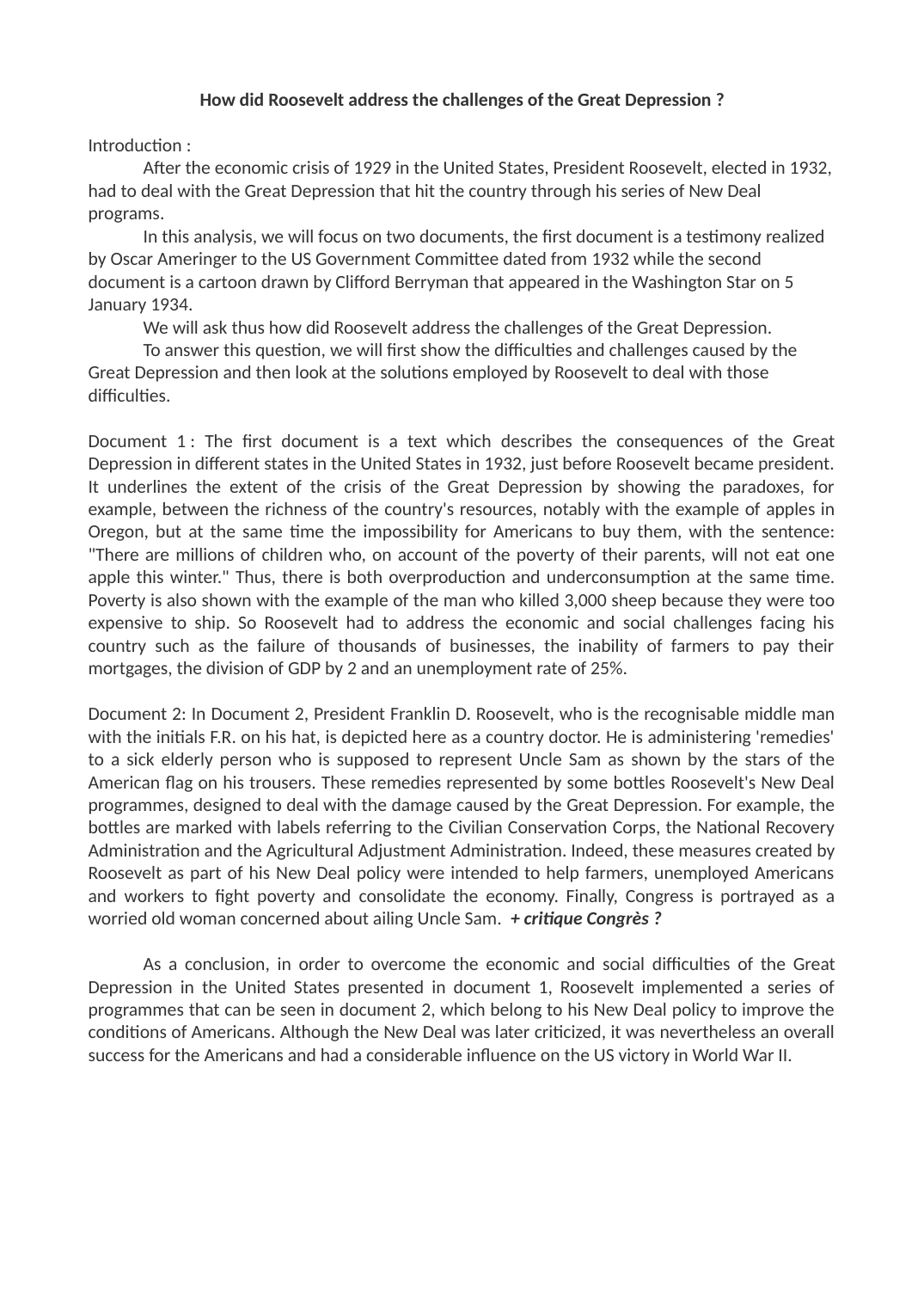How did Roosevelt address the challenges of the Great Depression ?
Publié le 05/02/2022

Extrait du document
«
How did Roosevelt address the challenges of the Great Depression ?
Introduction :
After the economic crisis of 1929 in the United States, President Roosevelt, elected in 1932,
had to deal with the Great Depression that hit the country through his series of New Deal
programs.
In this analysis, we will focus on two documents, the first document is a testimony realized
by Oscar Ameringer to the US Government Committee dated from 1932 while the second
document is a cartoon drawn by Clifford Berryman that appeared in the Washington Star on 5
January 1934.
We will ask thus how did Roosevelt address the challenges of the Great Depression.
To answer this question, we will first show the difficulties and challenges caused by the
Great Depression and then look at the solutions employed by Roosevelt to deal with those
difficulties.
Document 1 : The first document is a text which describes the consequences of the Great
Depression in different states in the United States in 1932, just before Roosevelt became president.
It underlines the extent of the crisis of the Great Depression by showing the paradoxes, for
example, between the richness of the country's resources, notably with the example of apples in
Oregon, but at the same time the impossibility for Americans to buy them, with the sentence:
"There are millions of children who, on account of the poverty of their parents, will not eat one
apple this winter." Thus, there is both overproduction and underconsumption at the same time.
Poverty is also shown with the example of the man who killed 3,000 sheep because they were too
expensive to ship.
So Roosevelt had to address the economic and social challenges facing his
country such as the failure of thousands of businesses, the inability of farmers to pay their
mortgages, the division of GDP by 2 and an unemployment rate of 25%.
Document 2: In Document 2, President Franklin D.
Roosevelt, who is the recognisable middle man
with the initials F.R.
on his hat, is depicted here as a country doctor.
He is administering 'remedies'
to a sick elderly person who is supposed to represent Uncle Sam as shown by the stars of the
American flag on his trousers.
These remedies represented by some bottles Roosevelt's New Deal
programmes, designed to deal with the damage caused by the Great Depression.
For example, the
bottles are marked with labels referring to the Civilian Conservation Corps, the National Recovery
Administration and the Agricultural Adjustment Administration.
Indeed, these measures created by
Roosevelt as part of his New Deal policy were intended to help farmers, unemployed Americans
and workers to fight poverty and consolidate the economy.
Finally, Congress is portrayed as a
worried old woman concerned about ailing Uncle Sam.
+ critique Congrès ?
As a conclusion, in order to overcome the economic and social difficulties of the Great
Depression in the United States presented in document 1, Roosevelt implemented a series of
programmes that can be seen in document 2, which belong to his New Deal policy to improve the
conditions of Americans.
Although the New Deal was later criticized, it was nevertheless an overall
success for the Americans and had a considerable influence on the US victory in World War II..
»
↓↓↓ APERÇU DU DOCUMENT ↓↓↓
Liens utiles
- the handmaid's tale: How far do you agree that Margaret Atwood makes resistance central to THT?
- How do the three documents interact to deal with the intersection of multiple identities?
- What are the influences of the Gilead society and how they have an impact on the woman’s lives?
- Education in Great Britain? Education is compulsory from the age of 5 (4 in Northern Ireland) to theage of 16.
- The Declaration of IndependenceIn the summer of 1776, more than a year after American colonists had begun their rebellion against Great Britain, the Second Continental Congress debated a resolution forindependence.


